How can I freeze my bread? (And thaw it, too!)
Keep loaves fresher for longer by stashing them in the freezer.
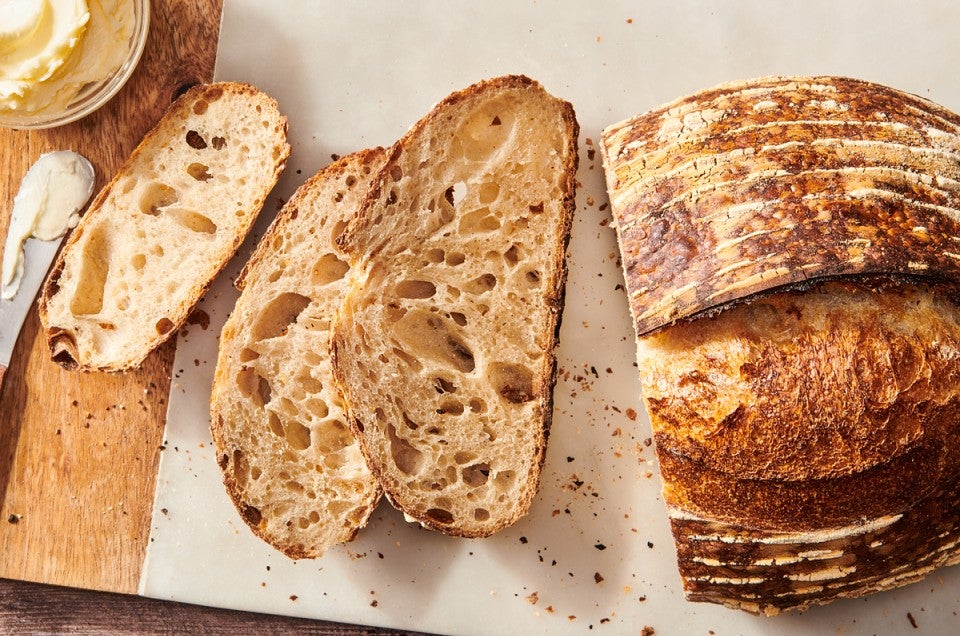

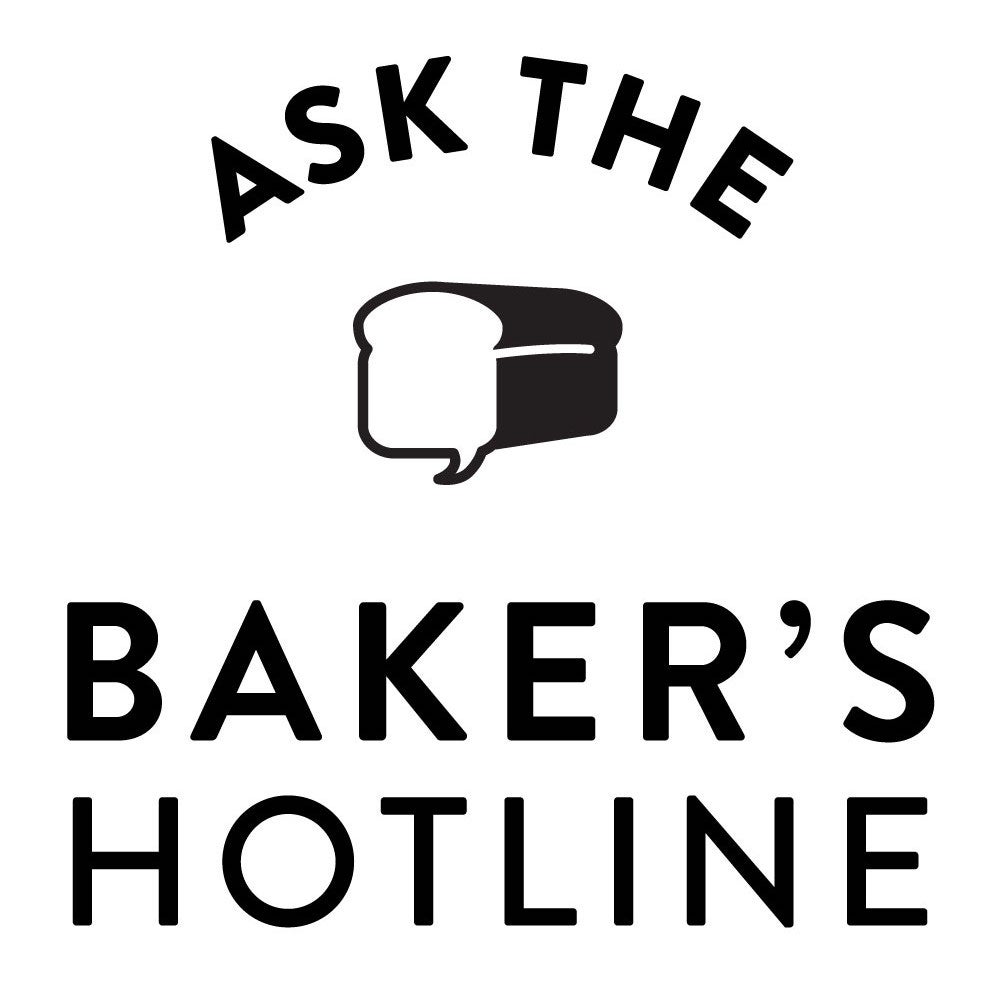 The bakers of King Arthur are here to solve the kitchen conundrums you share with us, whether it’s on the phone, computer, or by the good old postal service. In Ask the Baker’s Hotline, Annabelle will pick the brains of the talented King Arthur Baker’s Hotline team to tackle some of your most-asked questions. Today’s query: how to freeze (and thaw) bread.
The bakers of King Arthur are here to solve the kitchen conundrums you share with us, whether it’s on the phone, computer, or by the good old postal service. In Ask the Baker’s Hotline, Annabelle will pick the brains of the talented King Arthur Baker’s Hotline team to tackle some of your most-asked questions. Today’s query: how to freeze (and thaw) bread.
* * *
Clear out some freezer space — we’re here to talk about freezing bread! Because this household staple typically goes stale in a matter of days, the freezer is the best option to keep it fresh; it preserves freshly baked bread at its prime. And helpfully, most bread can be frozen for as long as three months. (But try to finish up gluten-free bread within one month, as it loses its integrity more quickly.)
With advice from The Baker’s Hotline’s own Maranda, we have the tips you need to properly store (and thaw!) bread and rolls to extend freshness and help you prep ahead for the holidays or gifting. (And if you’re looking to store uncooked dough rather than already baked loaves, learn how in our blog: Can I freeze my yeast dough?)
“Always let your bread or rolls cool completely before freezing them,” Maranda stresses.
If wrapped while hot, steam will be trapped and turned into condensation, prompting potential mold and bacteria growth on your bread. We want to avoid this! So, allow your bread to cool fully at room temperature. A cooling rack helps the bottom of your bread cool without losing any crispness that developed in the oven.
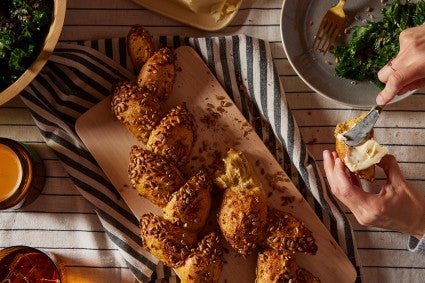
Look inside the freezer of a restaurant or bakery and you’ll find sheet pans of baked goods wrapped really, really well with many layers of plastic wrap. It might look excessive, but this is done to ensure baked goods aren’t exposed to air, which causes them to absorb odors and go stale much faster.
“I like to use multiple airtight layers,” Maranda shares. “For example, I’ll wrap a loaf with plastic and then place it in a bread bag. Or I’ll use foil as the first layer, then put it in an airtight container.” (For more single-use alternatives to wrap your bread, see our blog, How can I get single-use plastic out of my baking?)
Some breads, especially those served during the holiday season, call for some kind of topping after baking: melted butter, a confectioners’ sugar glaze, frosting, etc. “I always recommend waiting to add toppings or glazes before serving, after the bread has been thawed,” says Maranda.
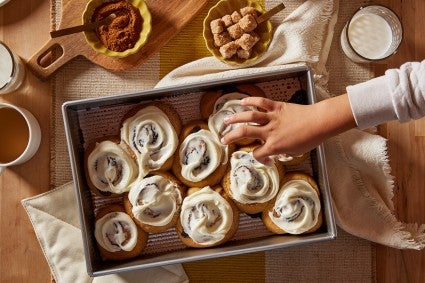
This goes for recipes topped with any sort of icing, like these Gingerbread Cinnamon Rolls with Cream Cheese Frosting, any bread brushed with a glaze, like Cardamom Buns, or breads finished with melted butter, like our Cacio e Pepe Clover Rolls.
For breads with dry toppings like seeds or nuts, you can simply freeze them as-is. Two gorgeous loaves from our Holiday Breads collection, Pumpkin-Sunflower Harvest Bread and Pistachio Cranberry Wreath, are both excellent candidates for baking and freezing ahead of a holiday celebration.
If you’ve ever tried to break single slices from a pre-sliced loaf of frozen sandwich bread, you know it isn’t particularly effective at anything other than making your hands cold. Maranda has some advice to help: “If you’re freezing sliced bread — which is a great way to keep the loaf fresh without thawing out more than necessary — I recommend dividing slices into groups of two or four (or however many you may use at one time), so you don’t have to thaw the entire loaf.” You could keep the slices grouped in reusable, individual bags or separate them with small squares of parchment paper.
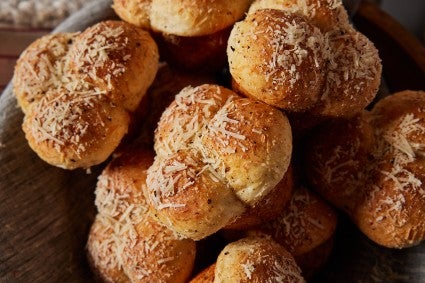
The best way to thaw bread and the fastest way to do so are not the same. First, let’s cover the best way. “Simply move the wrapped loaf from the freezer to room temp for three hours or so, though depending on the size of the loaf and the temperature of your kitchen, it may take longer,” Maranda says. “Rolls will take an hour, while slices should thaw in under 30 minutes — or they can be popped directly into the toaster from the freezer.”
Nothing beats freshly baked bread, but thawed bread that’s been properly frozen is about 90% as good. Give the crust of artisan loaves like baguettes or No-Knead Crusty White Bread a quick refresh in a 350°F oven, tenting with foil to prevent over-browning, if needed.
The fast way to thaw bread is not something I recommend doing for a full loaf of bread, but it can be helpful in a pinch: using the microwave. It’s best for thawing a single roll or a couple of slices of bread, preferably if you plan on toasting them or using them for a grilled sandwich, as the microwave has a tendency to dry bread out and leave it hard as a rock.
To thaw bread in the microwave, wrap each piece in a damp paper (or tea) towel, and microwave it on its own for 30 seconds. A roll may need up to 45 seconds. (You can use the same paper towel for each piece of bread if you’re thawing multiple.) It works well when you need a grilled cheese right now, but thawing at room temperature is always preferred for the ideal texture.
So as holiday breads are shared between friends and family, don’t fret about finishing it all at once. Make a little room in the freezer, wrap those festive loaves up tight, and you can enjoy them for months to come!
Watch Martin show you how to make picture-perfect Pumpkin-Sunflower Harvest Bread:
Cover photo by Rick Holbrook; food styling by Kaitlin Wayne.

